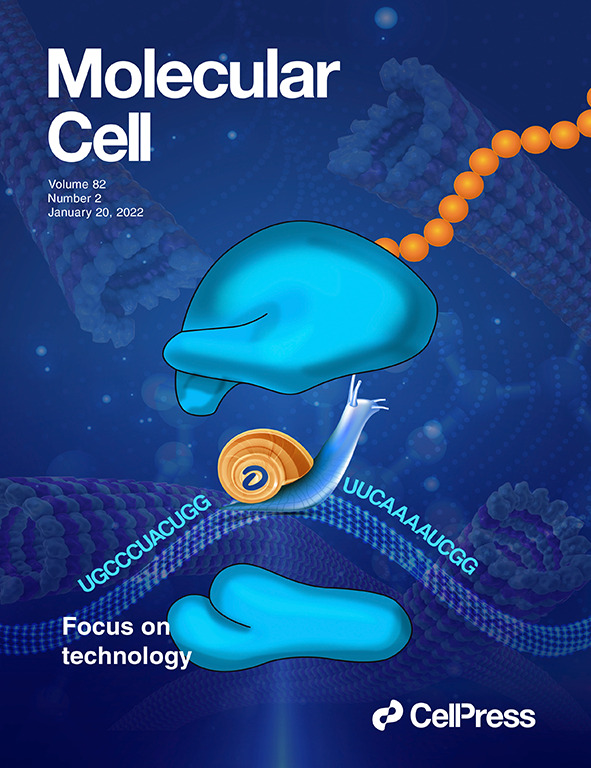toll样受体5在质膜上的电荷依赖定位。
IF 6.5
3区 生物学
Q2 BIOCHEMISTRY & MOLECULAR BIOLOGY
引用次数: 0
摘要
toll样受体(TLRs)的适当亚细胞定位对于启动针对病原体的适当先天免疫反应而避免自身反应是必不可少的。已知UNC93B1介导TLR9等核苷酸敏感tlr的细胞内运输,TLR9在到达细胞表面后迅速内化到内溶酶体中。我们之前证明了UNC93B1也促进了TLR5的质膜定位,TLR5是细菌鞭毛蛋白的传感器。与TLR9不同,在稳态条件下,TLR5在细胞表面保持稳定,表明其参与了不同的分选机制。使用基于诱变的方法,我们发现TLR5的胞质结构域是其表面保留所必需的,而TLR9的胞质结构域是其内化所必需的。值得注意的是,TLR5在其c端区域含有多碱基残基,这在其他tlr中是不存在的。这些残基的缺失或丙氨酸取代导致TLR5的组成性内吞作用。相反,将TLR5的c端区域附加到TLR9的c端,则促进了TLR9的表面积累。此外,当TLR5 c端序列与肉豆蔻酰化基序融合到胞质蛋白时,它以电荷依赖的方式介导了胞质蛋白的膜结合。我们进一步发现该区域可以直接与磷脂酸相互作用,磷脂酸是一种富含质膜的阴离子磷脂。这些发现揭示了TLR5选择性保留在质膜上的静电机制,为tlr的受体特异性定位提供了新的见解。资料可得性:支持本研究结果的所有数据均可在主稿件和补充信息文件中获得。本文章由计算机程序翻译,如有差异,请以英文原文为准。
Charge-dependent localization of Toll-like receptor 5 at the plasma membrane
Proper subcellular localization of Toll-like receptors (TLRs) is essential for initiating appropriate innate immune responses against pathogens while avoiding self-reactivity. Unc-93 homolog B1 (UNC93B1) is known to mediate the intracellular trafficking of nucleotide-sensing TLRs such as TLR9 which undergoes rapid internalization into endolysosomes upon reaching the cell surface. We previously demonstrated that UNC93B1 also facilitates the plasma membrane localization of TLR5, a sensor for bacterial flagellin. Unlike TLR9, TLR5 remained stably at the cell surface under steady-state conditions, suggesting the involvement of distinct sorting mechanisms. Using mutagenesis-based approaches, we found that the cytoplasmic domain of TLR5 is required for its surface retention, whereas the cytoplasmic domain of TLR9 is dispensable for internalization. Notably, TLR5 contains polybasic residues in its C-terminal region, absent in other TLRs. Deletion or alanine substitution of these residues led to constitutive endocytosis of TLR5. Conversely, appending the TLR5 C-terminal region to the C-terminus of TLR9 promoted its surface accumulation. Moreover, when the TLR5 C-terminal sequence was fused to a cytosolic protein along with a myristoylation motif, it mediated membrane association of the cytosolic protein in a charge-dependent manner. We further found that this region can directly interact with phosphatidic acid, an anionic phospholipid enriched in the plasma membrane. These findings reveal an electrostatic mechanism by which TLR5 is selectively retained at the plasma membrane, providing new insight into receptor-specific localization of TLRs.
求助全文
通过发布文献求助,成功后即可免费获取论文全文。
去求助
来源期刊

Molecules and Cells
生物-生化与分子生物学
CiteScore
6.60
自引率
10.50%
发文量
83
审稿时长
2.3 months
期刊介绍:
Molecules and Cells is an international on-line open-access journal devoted to the advancement and dissemination of fundamental knowledge in molecular and cellular biology. It was launched in 1990 and ISO abbreviation is "Mol. Cells". Reports on a broad range of topics of general interest to molecular and cell biologists are published. It is published on the last day of each month by the Korean Society for Molecular and Cellular Biology.
 求助内容:
求助内容: 应助结果提醒方式:
应助结果提醒方式:


